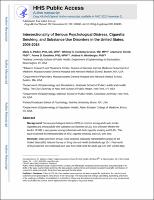Please use this identifier to cite or link to this item:
https://hdl.handle.net/20.500.12202/9418Full metadata record
| DC Field | Value | Language |
|---|---|---|
| dc.contributor.author | Parker, Maria A. | - |
| dc.contributor.author | Cordoba-Grueso, Whitney S. | - |
| dc.contributor.author | Streck, Joanna M. | - |
| dc.contributor.author | Goodwin, Renee D. | - |
| dc.contributor.author | Weinberger, Andrea H. | - |
| dc.date.accessioned | 2023-10-31T20:55:20Z | - |
| dc.date.available | 2023-10-31T20:55:20Z | - |
| dc.identifier.citation | Parker, M. A., Cordoba-Grueso, W. S., Streck, J. M., Goodwin, R. D., & Weinberger, A. H. (2021). Intersectionality of serious psychological distress, cigarette smoking, and substance use disorders in the United States: 2008–2018. Drug and Alcohol Dependence, 228, 109095. https://doi.org/10.1016/j.drugalcdep.2021.109095 | en_US |
| dc.identifier.issn | 0376-8716 (Print) 1879-0046 (Electronic) | - |
| dc.identifier.uri | https://hdl.handle.net/20.500.12202/9418 | - |
| dc.description | Scholarly article / Open Access | en_US |
| dc.description.abstract | __Background:__ Serious psychological distress (SPD) is common among adults who smoke cigarettes and among adults with substance use disorders (SUD). It is unknown whether the burden of SPD is even greater among individuals with both cigarette smoking and SUDs. This study examined the intersectionality of SPD, cigarette smoking, and SUD over time. __Methods:__ Data came from annual, cross-sectional, nationally representative samples of the United States (US) National Survey on Drug Use and Health (individuals age 12+). Past-month SPD prevalences were estimated each year from 2008-2018 for adults age 18+ with current daily, current non-daily, former, and never cigarette smoking by SUD status (combined n=441,286). Logistic regression models examined linear time trends of SPD. __Results:__ In 2018, SPD was significantly more prevalent among adults in each smoking group with SUD versus those without SUD (daily 29.1% vs. 9.0%, non-daily 23.2% vs. 8.6%, former 19.5% vs. 3.2%, never 16.4% vs. 4.3%). After adjusting for sociodemographics, SPD prevalence increased over time across smoking statuses with a larger change for persons with SUD (AOR=1.07; 95% CI: 1.06, 1.09) vs. no SUD (AOR=1.03; 95% CI: 1.02. 1.04). __Conclusions:__ SPD was more than twice as common among adults with SUD who smoke cigarettes compared to those without SUD who do not smoke cigarettes, with the highest prevalence among adults with both SUD and daily smoking. While SPD has increased over time, differences depended on SUD status beyond the effect of cigarette smoking. These results provide further evidence for treating smoking and mental health problems together. | en_US |
| dc.language.iso | en_US | en_US |
| dc.publisher | Elsevier | en_US |
| dc.relation.ispartofseries | Drug and Alcohol Dependence;228 | - |
| dc.rights | Attribution-NonCommercial-NoDerivs 3.0 United States | * |
| dc.rights.uri | http://creativecommons.org/licenses/by-nc-nd/3.0/us/ | * |
| dc.subject | Epidemiology | en_US |
| dc.subject | Tobacco Use | en_US |
| dc.subject | Substance Use Disorders | en_US |
| dc.subject | Serious Psychological Distress | en_US |
| dc.subject | Intersectionality | en_US |
| dc.title | Intersectionality of serious psychological distress, cigarette smoking, and substance use disorders in the United States: 2008–2018. | en_US |
| dc.type | Article | en_US |
| dc.identifier.doi | https://doi.org/10.1016/j.drugalcdep.2021.109095 | en_US |
| dc.contributor.orcid | 0000-0001-5502-1376 | en_US |
| local.yu.facultypage | https://www.yu.edu/faculty/pages/weinberger-andrea | en_US |
| Appears in Collections: | Ferkauf Graduate School of Psychology: Faculty Publications | |
Files in This Item:
| File | Description | Size | Format | |
|---|---|---|---|---|
| Weinberger 2021 OA Intersectionality nihms-1744613.pdf | 150.94 kB | Adobe PDF |  View/Open |
This item is licensed under a Creative Commons License

